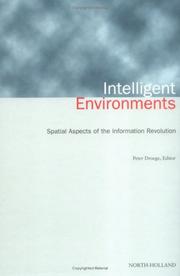| Listing 1 - 7 of 7 |
Sort by
|
Digital
ISBN: 9780081020753 0081020759 9780081020746 0081020740 Year: 2018 Publisher: Amsterdam Elsevier
Abstract | Keywords | Export | Availability | Bookmark
 Loading...
Loading...Choose an application
- Reference Manager
- EndNote
- RefWorks (Direct export to RefWorks)
Urban Energy Transition, second edition, is the definitive science and practice-based compendium of energy transformations in the global urban system. This volume is a timely and rich resource for all, as citizens, companies and their communities, from remote villages to megacities and metropolitan regions, rapidly move away from fossil fuel and nuclear power, to renewable energy as civic infrastructure investment, source of revenue and prosperity, and existential resilience strategy.

ISBN: 9780444823328 0444823328 9780080534848 0080534848 1281119970 9781281119971 9786611119973 6611119973 Year: 1997 Publisher: New York Elsevier
Abstract | Keywords | Export | Availability | Bookmark
 Loading...
Loading...Choose an application
- Reference Manager
- EndNote
- RefWorks (Direct export to RefWorks)
The environment, as modified and created by people, is largely about the use of information, its generation and exchange. How do recent innovations in the technologies of information management and communication affect our use of space and place, and the way we perceive and think about our surroundings? This volume provides an international, exploratory forum for the complex phenomenon of new information and communication technology as it permeates and transforms our physical world, and our relation to it: the architectural definition of our surrounding, geographical space, urban form and immediate habitats. This book is a reader, an attempt at registering disciplinary changes in context, at tracing subtexts for which most mainstream disciplines have no established language. The project is to give voice to an emerging meta-discipline that has its logic across the specializations. A wide range of professionals and academics report findings, views and ideas. Together, they describe the architecture of a postmodern paradigm: how swiftly mutating the proliferating technology applications have begun to interact with the construction and reading of physical space in architecture, economics, geography, history, planning, social sciences, transport, visual art - but also in the newer domains that have joined this spectrum through the very nature of their impacts: information technology and telecommunications. The space navigated in this volume is vast, both in physical terms and in its virtual and analogous form. It ranges from the space that immediately encompasses, or is simulated to encompass, the human body - as in buildings and virtual tectonics - to that of towns and regions. We stay clear of molecular-scale space, and of dimensions that are larger than earth.
Digital
ISBN: 9780080453415 0080453414 9780080560465 0080560466 Year: 2008 Publisher: London Elsevier
Abstract | Keywords | Export | Availability | Bookmark
 Loading...
Loading...Choose an application
- Reference Manager
- EndNote
- RefWorks (Direct export to RefWorks)
Contemporary cities, initially shaped by the logic of the Industrial Revolution, have evolved into a worldwide urbanization force, driven by readily available and relatively cheap fossil fuel supplies. They now face major changes as the fossil fuel era rapidly comes to a close. The end of this era marks the emergence of a new urbanism based on a massive energy transformation, characterized by the growing embrace of efficiency programs, sustainable forms of distributed energy generation, and new urban structures, market approaches, technologies, and policies. If a soft landing from the fossil fuel high can be engineered geo-regionally or even globally, successful strategies to preempt or adapt to change in realizing a sustainable, post-fossil fuel future will have to entail revolutions in urban energy infrastructure, city form, urban development logic, community culture, and management. This volume will characterize the nature of this historical change, and explore current initiatives to avoid a human, environmental, economical and cultural cataclysm, and to stabilize the long-term outlook for our urban communities.
Multi
ISBN: 9783031343629 9783031343612 9783031343636 9783031343643 Year: 2023 Publisher: Cham Springer International Publishing :Imprint: Springer
Abstract | Keywords | Export | Availability | Bookmark
 Loading...
Loading...Choose an application
- Reference Manager
- EndNote
- RefWorks (Direct export to RefWorks)
Demography --- Labour economics --- Social law. Labour law --- Business policy --- Personnel management --- Business management --- Information systems --- Economic geography --- organisatiemanagement --- demografie --- economie --- management --- sociaal recht --- arbeidsrecht --- coaching --- arbeid --- HRM (human resource management) --- organisatiecultuur --- database management --- geografie
Digital

ISBN: 9783868593495 9783868593433 Year: 2015 Publisher: Berlin JOVIS Verlag GmbH
Abstract | Keywords | Export | Availability | Bookmark
 Loading...
Loading...Choose an application
- Reference Manager
- EndNote
- RefWorks (Direct export to RefWorks)
Digital

ISBN: 9783868598889 9783868590760 Year: 2014 Publisher: Berlin JOVIS Verlag GmbH
Abstract | Keywords | Export | Availability | Bookmark
 Loading...
Loading...Choose an application
- Reference Manager
- EndNote
- RefWorks (Direct export to RefWorks)
Digital

ISBN: 9783868598902 9783868590746 Year: 2015 Publisher: Berlin JOVIS Verlag GmbH
Abstract | Keywords | Export | Availability | Bookmark
 Loading...
Loading...Choose an application
- Reference Manager
- EndNote
- RefWorks (Direct export to RefWorks)
| Listing 1 - 7 of 7 |
Sort by
|

 Search
Search Feedback
Feedback About UniCat
About UniCat  Help
Help News
News